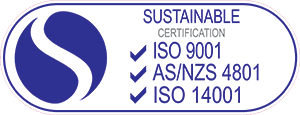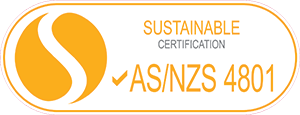Established in Sydney in 2003, Graffiti Clean is Australia’s only specialist provider of managed graffiti programs to Local Government. We currently serve over 16 local Governments in the greater Sydney and Wollongong area.
Our unique approach to managing graffiti, by directly targeting the motivations of graffiti vandals, has been repeatedly proven to be the most successful method of transforming even the worst affected municipal streetscape.
Coupled with the most advanced technology in the industry, and a commitment to ongoing innovation, Graffiti Clean remains at the cutting edge of Australian graffiti management best practice.
We recognize the importance of not only delivering an effective solution, but one that is safe, environmentally sustainable and of a consistently high quality. To that effect, all our processes have been independently certified against the Australian and International Standards for Quality, Safety, Environmental Management and Business Continuity.
Benefits
Property Managers
Working with Graffiti Clean gives you peace of mind. We are seldom far from sites you administer, quote quickly if required, and usually complete work by lunchtime the following day. (subject to size, location and weather).
Councils
Graffiti Clean is a proven, long term service provider with a deep understanding of Council requirements. We deliver quality results promptly, and provide fixed price options that remove the risk of budget over-runs. We are independently certified Quality Management System ISO 9001.
Utilities
We understand the safety and risk management concerns of utilities. Our coverage means we probably already cover a significant proportion of your assets. We train all staff to meet your specific requirements, in addition to meeting already-stringent safety standards. We are independently OH&S Best Practice ISO 4801.
Environment
Our equipment and systems are designed to minimise the amount of resources used for any job – using the least amount of water, chemical, waste water, packaging, etc. Cleaning products we use are chosen for their environmental compatibility, and we can achieve almost 100% recovery. We are independently certified Environment Best Practice ISO 14001.
Knowledge Centre
Fighting Graffiti
Why do People Write Graffiti?
To counter the effects of graffiti vandalism and effect a successful solution, it is necessary to investigate the main motivation of offenders.
A study by the Crime Prevention Division of the NSW Department of Justice (Graffiti Vandalism: The Motivations and Modus Operandi of Persons Who Do Graffiti, 2009) stated that the single biggest motivator of graffiti vandals was “illegal fame”, or recognition within the peer group. This study also found the greatest deterrent to repeat vandalism was a combination of rapid graffiti removal supported by effective repairs.
Denied the recognition they seek, graffiti vandals are more likely to target other, less well-maintained locations in the belief their tags will remain untouched for longer periods.
A secondary motivation for graffiti offenders is the desire to visibly impact their external environment; so repair quality also plays an important factor in discouraging repeat offences. Poorly completed or substandard repairs, where the effects of graffiti are still identifiable, will actually attract further attacks as offenders continue to clearly see the effects of their tagging (refer image 1).
When we understand the motivations of graffiti vandals, it is possible to develop an effective program, to not only effectively remove existing graffiti, but also act as a deterrent to further vandalism. Whilst it is not possible to completely eradicate graffiti from a city, over time an effective graffiti program can result in repeat/prolific offenders being pushed out of the area as they seek softer locations where they will gain better and more long-lasting recognition.
Why do people not like graffiti?
The City of Sydney’s graffiti policy summarises it thus: Graffiti impacts the community in a number of ways. Graffiti can have a negative impact on community amenity including perceptions of poor safety and increased crime. Graffiti can have a negative impact on the environment through pollution (including chemical and litter runoff into waterways), damage to items of environmental heritage and atmospheric impacts caused by aerosol sprays. Finally, graffiti impacts the community and the City financially through costs associated with its removal, management and associated decreased property values.
There is a strong consensus that noticeable graffiti means the overall image of the community is affected. Indifference to graffiti by property owners is seen as the sign of a careless management, or a poor corporate citizen because of the reflection on other property owners.
Protective Coatings
When should I consider an anti-graffiti surface coating?
- On soft stone walls or historic sites prone to graffiti
- High profile areas of brick or unpainted concrete (NB Fresh concrete must cure for at least 28 days before protection.)
- Light coloured brick, stone, or concrete
- Absorbent surfaces that cannot be overpainted – artworks, limestones, marbles etc.
- Busy pedestrian spaces with frequent graffiti attacks
- Biologically sensitive areas where containment and recapture of run-off is not possible.
What is an anti-graffiti coating?
An anti -graffiti coating is a surface treatment to prevent the permanent attachment of graffiti to the underlying surface. It assists the safe removal of most graffiti without damage to the substrate.
Why use an anti-graffiti coating?
Fragile surfaces: Some surfaces are especially vulnerable to permanent long-term damage from inks and spray cans, because they are porous and light coloured (e.g. light brick, sandstone, and unglazed terracotta).
Repeatedly targeted locations: Some areas are high profile and attractive to taggers, so they are continually attacked. Repeated graffiti removal treatment can lead to surface damage from frequent use of pressure washers, or a build-up of residual ‘shadows’ of past graffiti.
Unique surfaces: murals, artworks, sculptures and other valuable outdoor features need protection so the paints, surfaces and finishes that make them special are not compromised by graffiti or removal treatments.
What are the choices?
There are two main options with anti-graffiti coatings. We believe a sacrificial coating is usually best, for cost and environmental reasons.
Sacrificial coatings: clear, thin film emulsions or solutions applied to the surface to be protected. They may be applied directly over the bare substrate, or over other types of coatings. When defaced, the graffiti and sacrificial coating is removed (usually by hot water pressure washing), and if required a new coating is immediately reapplied.
The coating provides protection against spray paint, marker/felt-tip pens, pollution and grime. It also provides protection against salt and sea spray. It is permeable and allows the surface to breath, but prevents graffiti from penetrating into the substrate. It is non-toxic and biodegradable, and made from wax polymers that act as a building protection product. The coating flexes with the ambient temperature and is durable and UV stable.
Permanent two-pack coatings: provide a very hard, clear protective film over the substrate. Clear two-pack anti-graffiti coatings impart a distinct gloss or sheen, and can slightly darken some substrates such as concrete or bluestone. Graffiti is generally removed using aggressive graffiti removal agents that dissolve everything but the two-pack coating. Application of the coating requires special handling and it may contain VOCs. The coating and its application costs are more expensive than a sacrificial coating, and many are vulnerable to UV. Removal costs are high, because of the chemicals required and the environmental precautions they demand.
The Environment
Graffiti Clean holds ISO 14001 certification. Environmental considerations are built into the Graffiti Clean system. From procurement with recycling of packaging in mind, to selection of environmentally responsible chemical composition and usage we minimise the impact of our work. We minimise water usage by applying hot water for faster results, minimise waste paint and water by precision mixing, and carry wet and dry vacuums on all vehicles for water recovery if necessary.
Measures of Effectiveness
While Clean Sweep will reduce the incentives to create graffiti, it will not always eliminate it. The program will be successful in reducing graffiti, but sometimes a change in demographics, cultural issues, or changes in youth culture will lead to spikes and falls.
Measuring the amount of graffiti removed is a starting point, whether counted by square metres recovered, or number of graffiti treated.
A longer-term metric worth following is publicly reported graffiti – as we become more proactive, the number of public complaints of graffiti-hit assets (vs staff or tenant reports) will show a long-term decline. This metric is also a good indicator of community and stakeholder satisfaction.






